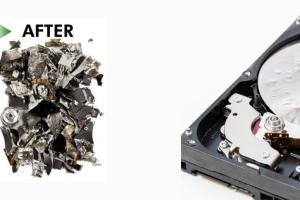Ultimate Guide: Destroying Hard Drives to Ensure Data Security

-
Quick Links:
- Introduction
- Why Destroy a Hard Drive?
- Methods of Destroying Hard Drives
- Data Destruction Software
- Physical Destruction Techniques
- Environmental Considerations
- Case Studies and Examples
- Expert Insights
- Step-by-Step Guide to Destroying Your Hard Drive
- FAQs
Introduction
In an age where data breaches and identity theft are rampant, ensuring the destruction of sensitive data is crucial. Whether you're disposing of an old computer or simply want to safeguard your personal information, understanding how to effectively destroy a hard drive is vital. This comprehensive guide will explore various methods, provide expert insights, and share case studies to help you navigate the complex landscape of data destruction.
Why Destroy a Hard Drive?
Data security is a growing concern for individuals and businesses alike. Here are some compelling reasons to destroy a hard drive:
- Prevent Identity Theft: Personal information can be extracted from discarded hard drives.
- Protect Business Data: Companies must safeguard proprietary information to maintain their competitive edge.
- Compliance: Many industries are subject to regulations that mandate proper data disposal.
- Peace of Mind: Knowing your data is irretrievable can alleviate anxiety related to potential breaches.
Methods of Destroying Hard Drives
There are various methods for destroying hard drives, each with its pros and cons. Here are the most common methods:
1. Data Wiping
Using software tools to overwrite existing data on the hard drive.
2. Degaussing
This involves using a degausser to disrupt the magnetic fields on the hard drive.
3. Physical Destruction
Physically tampering with the hard drive to render it unusable, such as shredding or drilling.
4. Incineration
Burning the hard drive in a controlled environment, ensuring complete destruction.
Data Destruction Software
Several software options can securely erase data. Notable tools include:
- DBAN (Darik's Boot and Nuke): A free tool that wipes data effectively.
- CCleaner: A popular software with a data wiping feature.
- Blancco: A professional-grade data wiping solution.
Physical Destruction Techniques
For those looking to ensure that data cannot be recovered, physical destruction may be necessary. Here are some common techniques:
1. Shredding
Using industrial shredders specifically designed for hard drives.
2. Drilling
Drilling multiple holes through the hard drive platters.
3. Hammering
Using a hammer to break the hard drive into pieces.
Environmental Considerations
It's important to consider the environmental impact of hard drive disposal. Many components can be recycled, so always consult local regulations regarding e-waste disposal.
Case Studies and Examples
Case Study 1: Corporate Data Breach
A major corporation faced a data breach due to improper disposal of hard drives. They learned the hard way that data destruction is paramount for protecting sensitive information.
Case Study 2: Personal Data Theft
A personal identity theft case highlighted the importance of securely destroying hard drives before disposal. The victim found their data on the dark web within weeks of throwing away their old computer.
Expert Insights
Industry experts emphasize that simply deleting files or formatting a hard drive is not enough. Data can often be recovered using specialized tools. Proper destruction methods are vital for ensuring data cannot be retrieved.
Step-by-Step Guide to Destroying Your Hard Drive
Follow these steps to securely destroy your hard drive:
- Backup Important Data: Always back up any necessary data before destruction.
- Choose a Destruction Method: Decide whether you will wipe, degauss, or physically destroy the drive.
- Use Destruction Software: If wiping, use reliable software to overwrite your data.
- Physically Destroy the Drive: If opting for physical destruction, ensure you follow safety protocols.
- Dispose Responsibly: Recycle components where possible and follow local e-waste regulations.
FAQs
1. What is the best way to destroy a hard drive?
The best method depends on your needs; degaussing and physical destruction are the most effective.
2. Can data be recovered after using data wiping software?
Generally, no, if done correctly. However, it's crucial to use reputable software.
3. Is physical destruction safe?
Yes, as long as safety precautions are followed. Wear safety gear and work in a safe environment.
4. Can I recycle my hard drive after destruction?
Yes, many components can be recycled. Check local regulations for e-waste disposal.
5. What if I want to sell my computer?
Make sure to wipe the hard drive securely before selling. Consider using professional services.
6. How do I know if my data is gone for good?
Using multiple data destruction methods can ensure data is completely unrecoverable.
7. What are the costs associated with data destruction?
Costs can vary based on the method chosen, ranging from free software to professional services.
8. Is degaussing effective for SSDs?
No, degaussing is primarily effective for traditional hard drives. SSDs require different methods.
9. Can I destroy a hard drive myself?
Yes, many people choose to destroy their hard drives themselves, but proper methods must be followed.
10. How often should I destroy my hard drives?
Whenever you replace or upgrade your hardware, ensure the old drives are destroyed securely.
By following the methods and guidelines outlined in this article, you can effectively destroy a hard drive and prevent data from being recovered, ensuring your personal and professional information remains secure.